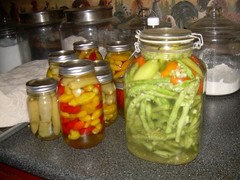Is this recipe safe?
I know nothing about fermentation!
3/4 to 1 pound fresh green beans
1 large clove garlic,
thinly sliced pinch red pepper flakes
1 teaspoon dried dill OR 3 to 4 sprigs fresh dill
1 1/2 Tablespoons unrefined sea salt
2 cups filtered water Instructions
Place half of the sliced garlic to a clean quart-sized mason jar, followed by the red pepper flakes and dill.
Snap off the stem-end of green beans. Blanch green beans in boiling water for 2 minutes, then immediately transfer to a bowl of ice water until no longer hot. Drain the blanched beans well and pat dry with paper towels.
Add green beans to your jar, stem-end down, packing them close together... it helps to lay the jar on its side at first. Fill the jar completely with the green beans, but do not pack them in too tight.
Sprinkle remaining garlic slices on top of beans in jar. In a bowl, or large glass measuring cup, mix together the water and salt. Pour this mixture into your jar of beans to cover, being sure to leave 1-inch space from the top of the jar for expansion. (If the brine does not cover, simply make up another batch using the same ratio of salt to water.)
Place lid (preferably air-lock lid) on the jar tightly. If using air-lock fill with water according to instructions.
Allow to ferment (culture) for 3 days at room temperature, checking after day 2. When they are done, the beans will smell and taste "pickled", but they should still be slightly crisp.
Remove air-lock lid, if using, and replace with storage lid. Transfer to cold storage.
Comments (57)
NilaJones
Original Author10 years ago>But you'll eat 3 day and older NON FERMENTED raw veggies without a second thought about listeria; why is that?
I wouldn't, not green beans. I got food poisoning once from non-fermented raw green beans that were in the fridge too long, so I am extra-concerned about beany things :).
Consequently, I am careful to get my garden-harvested ones into my very cold fridge within an hour, preferably within 30 minutes, and eat them within a week.
Non-bean vegies like zucchini or something, stored 3 days at room temperature... I would probably eat them if I were camping or something and didn't have alternatives, and if they had not been stored in something anaerobic-promoting like plastic bags. But they would be pretty limp and would have lost a lot of nutritional value.
Some stuff -- onions, garlic, sweet potatoes, fruits, tomatoes -- keeps a long time at room temp. But you'll notice that fruits or tomatoes that have been cut go bad very quickly at room temp. They need their skins intact. Sometimes onions and sweet taters mold or rot at injury sites too.
Related Professionals
Lowell Landscape Architects & Landscape Designers · Aberdeen Landscape Contractors · Bethel Park Landscape Contractors · Bridgeport Landscape Contractors · Dudley Landscape Contractors · Porterville Landscape Contractors · Salem Landscape Contractors · Streamwood Landscape Contractors · Wells Landscape Contractors · Wheat Ridge Landscape Contractors · Georgetown Roofing & Gutters · Huntsville Roofing & Gutters · Phoenix Roofing & Gutters · Hinsdale Roofing & Gutters · Wilton Manors Roofing & Guttersreadinglady
10 years agoI don't think we need to become paranoid about the risks but to deny there's risk is not wise either.
There's a much higher awareness of listeria than there used to be and research is ongoing. One of the greatest areas of risk is RTE (ready-to-eat) refrigerated foods, especially those kept refrigerated beyond the recommended date. IIRC, the first documented incidence of listeria was in a prepared coleslaw.
Listeria often flies under the radar because many people assume if something is refrigerated it's safe until some sort of spoilage is obvious, but because pathogens like listeria can grow comfortably at cold temperatures that isn't the case.
In food preservation it's the reason refrigerated pickles which were fermented for a short period (i.e. 3 days to a week) and then refrigerated were pulled from NCHFP and other Extension sites. Listeria did grow in those pickles.
A lot of problems with listeria also develop during food preparation as a result of less-than-sanitary food handling practices. Following the usual reasonable precautions can go a long ways to preventing problems.
But, it is also true that listeria is quite resistant or, you could say, good at escaping even when efforts are made. The biggest issue is that we have so many individuals alive now through medical intervention who lack the immune resources to fend off what might not bother a healthy person at all.
I am not opposed to raw vegetables and I'm certainly not opposed to fermented ones. I like them, though I'm also aware that some nutrients become more accessible through cooking. It depends.
Actually, though this is another topic, I wish every child were raised with a dog in the house and some pigs in the back yard. Then we'd have a lot fewer worries about immune susceptibilities (and allergies). As a child I ate my share of veggies straight from the ground. A lot of us did that and lived to tell about it.
Carol
2ajsmama
10 years agoOK, to get really OT, did you see that the new Food Safety Modernization Act wants to have growers practically raise everything in a bubble? I'd love it if I could exclude all wildlife from my gardens but I just fence for deer, too expensive to exclude all mammals and birds (as far as I know they aren't requiring you to keep insects out LOL).
All because some big farms are having trouble getting their workers to use proper hygiene (or they're not providing access to it).
I have to tell people at market they should wash everything before eating it, though I did do an ice-water dunk on my beans when I picked them on a hot day I can't sell anything as "washed and ready to eat". But I let my kids eat beans and tomatoes and berries as they pick (I do wash the sooty blotch and flyspeck off the apples). I won't let them eat any store-bought or conventionally-raised produce without washing it.
malna
10 years agoI'm well on my way to eating that pound of dirt that my Gram told me I needed to. So far, she's been right - haven't had to take antibiotics in years (besides, they make me sicker than whatever I had in the first place LOL).
ajsmama, I love that "let's all garden in a bubble" answer to everything that ails us. I also fence for rabbits/deer but I did, however, get a bit miffed at the bear that pushed over a section of fence and pooped in the lettuce bed. I drew the line at eating that produce :-)
cannond
10 years ago"Most other lacto recipes for pickled green beans also do not call for blanching as in the recipe below."
Kaufmann and Schoneck, in their book about sauerkraut and fermenting, report that raw green beans contain a toxin called phasin that interferes with digestion. Phasin, they say, decomposes when heated. They suggest cooking beans for five to ten minutes (depending on the tenderness of the bean) before fermenting.
In my own experience fermented dilly beans that have been blanched have a better texture. I always ferment them 10 days to 2 weeks.
Also, the beans should be weighted down during the ferment. It's an anaerobic process. Floating beans promote molds.
In an age when compromised immune systems have become ubiquitous, listeria is nothing to fool with.
Deborah
NilaJones
Original Author10 years agoI graze in my garden every day :). Though I do wash stuff if I bring it indoors, and everything from the store.
I also eat most of my green beans raw in the summertime. Sometimes I cook them for a change of pace. This is bad?
I have always preferred legumes raw -- even when I was a kid and we were shelling peas for dinner I would ask to save my portion aside from the cooking pot. My parents, unsure, how to serve raw peas, gave them to me in a bowl with a spoon :).
I try to be alert for animal poo in the garden. I had a huge batch of 'composted' manure one year that turned out to have giardia in it. Killed my cat :(((. The plants love the soil, though. I covered the bed with fabric and 6" of mulch, and I wash anything from that bed. Mostly just grow fruit trees and squashes there -- they are up high or cooked before eating, respectively.
cannond
10 years ago"I also eat most of my green beans raw in the summertime. Sometimes I cook them for a change of pace. This is bad?
Not bad, necessarily, just not optimum for nutrition.
In other words, you might gain more benefit from the beans and other foods you ingest at the same time, if the phasin has been neutralized.
I think a lot of this is theoretical. Let's face it, science, especially nutritional science, keeps morphing on us. Eggs are bad...eggs are good. Animal fat is bad... animal fat is essential for optimal brain function. You get the idea.
If you prefer your beans raw and you aren't suffering any nutritional deficiencies or gastric complaints,,, eat away!
Deborah
digdirt2
10 years agoNila -what canning books do you have access to? There is all the basic fermentation info on NCHFP but Ziedrich's Joy of Pickling had a great, detailed section on it, how it works, the various brine % rates that are recommended and those not recommended, the safety concerns, recipes for many different vegetables, etc.
Her blog http://agardenerstable.com/category/fermented-foods/ also has a fair amount of info on fermenting.
If you'd like to try Zeidrich's Fermented Green Beans recipe and don't have access to the book I'll be glad to post it for you.
Dave
2ajsmama
10 years agoThe bears have been pretty well-behaved this year - stayed out of the berries - though now we have SWD so I wish they'd rip through the wild blackberries again. They seem to prefer garbage - I've been throwing my tomato pulp/cores, apple cores, all fruit in the garbage rather than composting, and they are going after that even with ammonia sprayed on the can. Then again, it could just be the same bear that decided last year to tip all our sand barrels along the driveway b/c barrel = food, right?
No problems with rabbits even without burying the fence, though possibly some got into peppers (fenced with CRW) last year. The squirrels got into the (netted) strawberries though.
Really, if I could keep the JB and loopers and SWD and SVB et al out while keeping the pollinators, I'd be doing great. Maybe I have to look for parthenocarpic everything and just use row covers - that would make the FDA happy.
I'm going to have to try the fermented beans - we love Linda Z's half sours, I've never tried dilly beans but since we're running out of freezer space it's worth a try. Just don't think I'll PC any since my mom is the only one who would eat them.
NilaJones
Original Author10 years agoOh, Dave, you are so kind! I bought the Joy of Pickling the day I saw it recommended here (was that you, or Carol?). I just haven't absorbed it all, yet :).
@ajsmama: Isn't the SWD sit horrible! i found them in my asian pears the other day. First time it has fruited in 5 years -- it finally found a mate, and now this :(.
sidhartha0209
10 years agocannond:
"Kaufmann and Schoneck, in their book about sauerkraut and fermenting, report that raw green beans contain a toxin called phasin that interferes with digestion. Phasin, they say, decomposes when heated. They suggest cooking beans for five to ten minutes (depending on the tenderness of the bean) before fermenting."I don't have that book, but I do have 'The Art of Fermentation' by Sandor Katz, who addresses this very reference and basically has decided the Europeans are referring to the beans, not the pods, to which this also agrees:
"I have the book ["Making Sauerkraut and Pickled
Vegetables at Home", by Klaus Kaufmann] and read it the same way at first, likely influenced by the nice picture of string beans adjacent the text you quoted. But after re-reading it, i believe that the sentence you quoted is aimed specifically at the bean seeds typically dried and boiled, like the kidney beans. Note, the next paragraph/sentence says "Cut, wax and string beans, as well as broad or "tick" beans are suitable for lactic acid fermentation". Lack of precise wording/communication by the authors appears to be the problem here, not poisons in string beans.I think that toxicity of "green" beans as described by Europeans might refer to, e.g., fresh kidney beans and pods, where 'green' indicates the quality of live from the vine and not dried and cooked. Another American name for string beans is 'green beans' but this may not be the case in Germany."
Here is a link that might be useful: Green Beans & Phasin?
sidhartha0209
10 years agoCarol:
"In food preservation it's the reason refrigerated pickles which were fermented for a short period (i.e. 3 days to a week) and then refrigerated were pulled from NCHFP and other Extension sites. Listeria did grow in those pickles."Carol, I thought this was an excellent post you made, so don't let me being the skeptic that I am depreciate that observation, but, you do realize what the 'fly in the ointment' here is don't you? The researchers INNOCUNULATED the cukes with the bacterium, evidently by deep injection also. Coupled with the fact(s) that there are no reported cases of listeriosis from fermented vegetables (yea, any food borne illness at all), and, I'm doing the very opposite of those researchers, I'm washing/cleaning my homegrown cukes, not contaminating them with the bacterium. I'm practicing good hygiene with my cukes from garden to kitchen to fermenting vessel.
Nah, it's hard for me to lose any sleep from fear of listeria in my half sours.
This post was edited by sidhartha0209 on Thu, Sep 12, 13 at 10:33
NilaJones
Original Author10 years ago>I think that toxicity of "green" beans as described by Europeans might refer to, e.g., fresh kidney beans and pods, where 'green' indicates the quality of live from the vine and not dried and cooked. Another American name for string beans is 'green beans' but this may not be the case in Germany.
Interesting point. I wonder if its a reference to young, green fava beans -- not the pods, but the beans. Favas ARE often eaten pickled.
sidhartha0209
10 years agoThis year I grew only two short rows of Roma 2 bush beans and, for the first time, one large teepee (about 30 plants) of Fortex pole beans. We love the Fortex raw about as much as cooked, and it makes very good pickled beans. However I stumbled upon a two lb. pack of WalMart green beans the other day that are the most delicious sweet crisp raw green beans I've ever tasted, I'd love to know what variety it is, I may call the company and quiz them about it.
Anyhoo, a 2 lb. package (less a few pods eaten raw) filled a 1/2 gallon jug . I added several cloves of garlic and 3-4 beans finely minced, 4-5 small hot chiles crushed, 2 tsp peppercorns, 1 TBSP dried dill weed, 3 TBSP salt, and covered with water. Green beans seem to take longer to ferment than other things, these should be ready to go to the fridge in 7-10 days.

cannond
10 years agoI have a couple of questions about your beans. Why do you mince some of them? Don't you weigh them down? No air lock?
Looking at my recipe, I ferment beans for three weeks.
Deborah
sidhartha0209
10 years ago"Why do you mince some of them?"
For flavoring and to jump start the ferment, as in pounding/pulverizing cabbage for kraut. I always sacrifice a cuke in the same manner for half/full sours. It took me a while to figure out that's one of Ba-Tampte Pickle ingredients in their brine, pureed cuke.
"Don't you weigh them down?"
If I'm unable to wedge them down below surface I do, which basically amounts to having the right size jar for the batch. If jar is too big I'll use a zip lock w/water in it as a weight.
"No air lock?"
No air lock.
"Looking at my recipe, I ferment beans for three weeks."
Most likely the fermenting is done before that, what you're doing is 'curing' the beans, as in salt concentration reaching equilibrium throughout brine and solids.
I'll 'ferment' for as long as I think necessary, and then stick them in the fridge to 'cure', or 'season', or whatever.
This post was edited by sidhartha0209 on Wed, Sep 18, 13 at 13:37
sidhartha0209
10 years agoThe last batch I pickled was too small for the jar, so I topped off the jar and 'wedged' chile peppers in at the top in order to keep everything below surface.

2ajsmama
10 years agoLinda Z's half sours are better than Ba-Tampte. In fact, I bought some before my cukes started fruiting and didn't care for them at all - I let DH and DS finish them. I'd rather have homemade. And they ferment just fine without a sacrificial cuke ;-)
I too use a ziploc filled with brine as a weight - no air lock. I ferment in food-safe plastic buckets (from olives, icing, etc., pick up at delis and grocery bakeries) and snap the lid on about 3/4 of the way around to hold the brine bag down but still let some air in.
readinglady
10 years agoI do not see the injection of cucumbers with Listeria Monocytogenes as problematic. We already know Listeria is present in the soil, in water and is therefore transferred to vegetables. The point of the study was to determine under what conditions pickles would provide a congenial environment for growth and that was achieved.
It seems to me that the risk would be neglible if the hands were thoroughly washed, if the cucumbers (unbroken skins) were similarly washed, if the water were clean, etc. etc. However, the NCHFP is a resource used by home food preservers of every skill level and consumers with varying degrees of health. So even a negligible risk is not in their purview.
But some people will continue to use these recipes regardless. That's just human nature. Odds are the overwhelming majority will do just fine.
Carol
Here is a link that might be useful: Listeria monocytogenes survival in refrigerator dill pickles
cannond
10 years agoThat was a helpful link, Carol. How does this bode for fermented refrigerated sauerkraut? Six week ferment, refrigerated...listeria here, too?
I'm utterly confused. On the one hand we need the probiotics, which are killed along with the listeria when heated.
Between a rock and a hard place.
Deborahcannond
10 years agoI think I may have asked this before. I'm too tired to think straight. It's a good thing I'm not canning tonight!
Deborah
sidhartha0209
10 years ago"I do not see the injection of cucumbers with Listeria Monocytogenes as problematic."
???
I do not see the research as being anything but skewed. What the researchers did was no different than dropping a turd into the final stage of pickling AFTER washing the cukes. A much more realistic test would have been to inoculate cucumber surfaces only while still on the vine, and THEN monitor for listeria growth during the fermentation phase.
It blows my mind, there have been no reported cases of any sort of food born illness from fermented vegetables, let alone listeria, ever, and folks let biased/distorted 'research' such as this frighten them away from good wholesome homemade food. Ridiculous.
theforgottenone1013 (SE MI zone 5b/6a)
10 years agoWhat do you consider a well-washed veggie? Is it just washed with water? Soap? A vinegar wash? Bleach?
From my understanding, which I could be wrong since I haven't done much researching, you need the good bacteria that's on the skin of the veggies to start the fermentation process. So if you used anything other/stronger than water, wouldn't the good bacteria be killed? Also, if after washing in water there are enough good bacteria to start the ferment, wouldn't there potentially be enough listeria on the veggies to cause illness?
Rodney
sidhartha0209
10 years ago"What do you consider a well-washed veggie? Is it just washed with water? Soap? A vinegar wash? Bleach?":
"General recommendations to prevent an infection with Listeria:
FDA recommendations for washing and handling food.
â¢Rinse raw produce, such as fruits and vegetables, thoroughly under running tap water before eating, cutting, or cooking. Even if the produce will be peeled, it should still be washed first.
â¢Scrub firm produce, such as melons and cucumbers, with a clean produce brush.
â¢Dry the produce with a clean cloth or paper towel.
â¢Separate uncooked meats and poultry from vegetables, cooked foods, and ready-to-eat foods".
---------------------------
"From my understanding, which I could be wrong since I haven't done much researching, you need the good bacteria that's on the skin of the veggies to start the fermentation process. So if you used anything other/stronger than water, wouldn't the good bacteria be killed?"
I've wondered the same thing. Lactobacilli are found primarily on the surface but are also internal, thus crushing/pounding/pulverizing has become common practice to the art of fermentation.
-------------------------------------
"Also, if after washing in water there are enough good bacteria to start the ferment, wouldn't there potentially be enough listeria on the veggies to cause illness?"
Lactobacilli are the champs at 'competitive exclusion'.
"Fred Breidt, USDA specialist, on fermented vegetables: "There has never been a documented case of foodborne illness from fermented vegetables. Risky is not a word I would use to describe vegetable fermentation."*..."
"Breidt said that there are no documented cases of food-borne illness from fermented vegetables, and they are much safer for novices to make than home-canned vegetables. Pressurized canning creates an anaerobic environment that increases the risk of deadly botulism, particularly with low-acid foods. "With fermented products there is no safety concern. The reason is the lactic acid bacteria that carry out the fermentation are the world's best killers of other bacteria."..."
Here is a link that might be useful: CDC-How can I reduce my risk for listeriosis?
sidhartha0209
10 years agocannond:
"... How does this bode for fermented refrigerated sauerkraut? Six week ferment, refrigerated...listeria here, too?..."I'm sure if the 'researchers' had dropped the turd into the freshly washed shredded cabbage the results would be the same. Folks would be frightened away from even more good wholesome homemade food.
It's odd they haven't done that yet, don't you think?
NilaJones
Original Author10 years agoYou know, your paranoia and ignorance about the scientific process just makes people more likely to ignore the parts of your ideas that might be valid. You're not doing yourself any favors.
-Nila, who hails from a forum less gentle than this one.
sidhartha0209
10 years agoI'm paranoid and ignorant? I would think those here that believe a ferment in progress is normally toxic would fit that description.
I'll rephrase my last post:
"I'm sure if the 'researchers' had inoculated freshly washed shredded cabbage with listeria monocytogenes, the results would be the same. Folks would be frightened away from even more good wholesome homemade food.
It's odd they haven't done that yet, don't you think?"
This post was edited by sidhartha0209 on Fri, Sep 20, 13 at 7:02
sidhartha0209
10 years agoKraut HAS been tested! The lactobacilli eventually win out in the end it appears. Cool!
"... E. coli O157:H7 and L. monocytogenes persisted in the brines for most of the fermentation, although at the end of the fermentations (15 days for shredded, 28 days for whole head), neither pathogen had detectable populations..."
[edit]
Oops - "...Acid-tolerant strains of E. coli and L. monocytogenes were isolated from both shredded and whole-head sauerkraut at different salt concentrations and temperatures after 15 days of fermentation and could be detected at 35 days in the wholehead sauerkraut...."
Acid resistant strains persisted. Oh my, now what?
Here is a link that might be useful: Survival of Listeria monocytogenes and Escherichia coli O157:H7 during sauerkraut fermentation
This post was edited by sidhartha0209 on Fri, Sep 20, 13 at 9:19
digdirt2
10 years agoHow does this bode for fermented refrigerated sauerkraut? Six week ferment, refrigerated...listeria here, too?
The point that keeps getting missed is the salt brine percentage. They tested three % levels of brine - 1.3, 3.8 and 7.6%. The minimum recommended brine level is 2.57% (1.5T to quart of water) but it also has the shortest safe shelf life. The stronger the brine, the higher the % of salt, the safer the fermentation and the longer the shelf life.
There was approximately a 1-log increase during fermentation at room temperature followed by a population decline during refrigerator storage, with a greater decrease in the pickles with the highest NaCl content. Populations of total aerobes and lactic acid bacteria increased.
So the higher the salt brine % the lower the population of pathogenic bacteria and the greater the population of beneficial bacteria.
Use the proper salt brine % for your fermentation of any foods and no worries as long as it is refrigerated storage after fermentation. Use a reduced salt brine % level or store at room temperature after fermentation at your own risk.
That is why the sauerkraut instructions provide specific amounts of salt required (a 4.98% brine), warn against reducing it, lists the temps needed for proper fermentation, and follow up with fridge storage for approx. 6 months safe consumption.
So to answer your question, properly done and stored fermented sauerkraut poses no risks of listeria.
Fermentation, when properly done, is a great method of food preservation and practiced by many of us here. No one has ever stated or even implied that "a ferment in progress is normally toxic". That claim is nothing more than your interpretation because some of us disagree with some of your methodology.
My fridge currently holds several jars of fermented garlic dills made from several different recipes, a gallon jar of fermented green beans, 3 gallon jars of sauerkraut, fermented hot n' sweet peppers, and my Harsh crock is currently in week 2 of fermented sweet pepper mash. All were made with at least a 3.35 % (2 T per quart) brine except the kraut which used a 4.98% brine (3/4c to 1 gallon water). And all are perfectly safe to consume for 4-6 months.
Dave
cannond
10 years agoThank you, Dave. You've soothed my frazzled nerves.
Now, could you point me in the right direction for the hot n' sweet peppers and the sweet pepper mash? These sound wonderful.
Deborah
sidhartha0209
10 years agodigdirt:
".. No one has ever stated or even implied that "a ferment in progress is normally toxic". That claim is nothing more than your interpretation because some of us disagree with some of your methodology...."I ferment salsa from fresh raw ingredients and will normally eat from it everyday while fermenting.
Is this unsafe? If so, why?
digdirt2
10 years agodigdirt:
".. No one has ever stated or even implied that "a ferment in progress is normally toxic". That claim is nothing more than your interpretation because some of us disagree with some of your methodology...."
I ferment salsa from fresh raw ingredients and will normally eat from it everyday while fermenting. Is this unsafe? If so, why?With the qualifiers mentioned above - proper brine %, proper food cleaning, proper ambient temps, etc. - no, likely it is not unsafe for healthy immune systems, merely somewhat risky.
But the real issue is that there is no way to know for sure without measuring the pH and culturing the food and see what grows out. That is what was done in the testing article Carol linked. Note for example that it was 4 days before a notable drop in pH occurred in the testing and the amount of listeria steadily declined from that point on.
That is why it is recommended that foods be left to ferment for a minimum of 7 days prior to consuming them. That insures the pH has sufficiently declined, the beneficial bacteria have sufficient time to develop and pathogenic bacteria that might have been there has declined.
So consuming the food at day one would only get you the bacteria on the food to begin with if any, days 2, 3, and 4 may be somewhat more risky as those bacteria have had time to proliferate while the control level is still low. From day 5 on the risk level falls and the safety level rises.
But when one thinks about it, if the goal is the flavor, texture, probiotics, and overall quality of fermented food, why would one want to eat it so early anyway?
Safety, pH and bacteria issues aside the flavor and texture isn't there yet and neither is the truly desirable level of probiotics. Minimal if any benefits vs. potential risk doesn't compute. So why eat it?
In other words, day 1-7 food isn't actually fermented yet anyway. It is just food soaking in salt water. So why eat it? Day 7-14 fermented food isn't near as good as day 21 will be, etc. So if fermented food is what you want, then give it the time to actually ferment before eating it.
Dave
NilaJones
Original Author10 years agoI would not be worried about salsa because it doesn't have ingredients conducive to most kinds of food poisoning. I wouldn't be surprised if it went through a less-palatable stage at some point, but I would not expect to get sick from it.
This is just my experience as a cook talking -- I don't know anything about the microbiology of salsa, but others here likely will.
digdirt2
10 years agoNow, could you point me in the right direction for the hot n' sweet peppers and the sweet pepper mash? These sound wonderful.
Deborah - no specific recipe is required for fermenting either although both are basically just Ziedrich's recipe for Brined Peppers from Joy of Pickling p.71.
Both are basically chopped peppers - one a mix of 3/4 various sweets and about 1/4 jalapenos - and the other all mixed sweets.
To each quart of chopped peppers we add 1-2 T mixed pickling spices and then pour on the salt brine mixture to cover. So the total amounts depends the size container you use. We use a 7 gallon or 10 gallon crock.
The hot n' sweet mix we cut into bite size chunks since we use them to make dishes like Italian Beef and Smoked Sausage with Peppers where that size works best. The sweets we coarse chop and use it primarily as a relish for hot dogs, hamburgers and sanwiches.
For Example: 1 quart jar filled 3/4 full with chopped peppers, 1 T mixed pickling spices, 1 quart water with 2 1/2 T pickling salt (1.46 oz.) dissolved in it for a 4.19% brine. Loosely cap, set in an out of the way dark corner out of the sun on a plate to catch any overflow. Room temp 70-75 degrees. Skim top as needed every 3 days. After 7 days taste to see if you like them yet. We usually let ours go for 3 weeks and then put them in the fridge.
If you want to do a lot of fermenting then I strongly recommend Joy of Pickling as it has many great recipes and covers all the basics in detail.
Dave
cannond
10 years agoThanks, Dave. I appreciate that. Italian beef? I'll have to look that one up. Sounds promising.
I do have Joy of Pickling. I didn't realize those recipes were in there. Thanks again.
Deborah
digdirt2
10 years agoAll of Chap 2 in JOP. Italian Beef is easy crockpot meal. Any beef roast, 1 jar of beef broth, 1-2 c mild to hot peppers (pepperochini, banana, mixed, your choice), 1 T mixed Italian Seasoning. Cook all day. An hour before serving remove the roast and shred it and throw it back in the pot for an hour. Sever on Kaiser rolls with liquid on the side for dipping.
Dave
sidhartha0209
10 years agocannond:
"Thank you, Dave. You've soothed my frazzled nerves"Lol, what's got your nerves frazzled? Finding out that raw green beans aren't poisonous after all?
Dave, come on, answer my question:
"I ferment salsa from fresh raw ingredients and will normally eat from it everyday while fermenting.
Is this unsafe? If so, why?"
cannond
10 years ago"Lol, what's got your nerves frazzled? Finding out that raw green beans aren't poisonous after all? "
Is civil discourse utterly beyond you? You've gone from being contentious to coarse to sophomoric.
Your credibility diminishes apace.
Deborah
cannond
10 years agoDave, I look forward to the Italian beef. In canning season, especially, simple meals are a boon.
Thanks.
Deborah
digdirt2
10 years agoDave, come on, answer my question:
"I ferment salsa from fresh raw ingredients and will normally eat from it everyday while fermenting.
Is this unsafe? If so, why?"
I already answered it in great detail above yesterday. All you have to do is read the post Fri, Sep 20, 13 at 15:56
Dave
sidhartha0209
10 years agodigdirt:
"But the real issue is that there is no way to know for sure without measuring the pH and culturing the food and see what grows out. That is what was done in the testing article Carol linked. Note for example that it was 4 days before a notable drop in pH occurred in the testing and the amount of listeria steadily declined from that point on.That is why it is recommended that foods be left to ferment for a minimum of 7 days prior to consuming them. That insures the pH has sufficiently declined, the beneficial bacteria have sufficient time to develop and pathogenic bacteria that might have been there has declined."
The listeria hysteria is becoming comical to me. My recommendation to those who want to enjoy 'half ferments' is simply don't follow the recipe that the researchers did. Omit the step where the filth is added. Kinda like home prepared cole slaw, don't spit a loogie in it before putting it in the fridge, It really is that simple.
If you had even one documented case of food born illness from fermented vegetables, the conclusions of this 'research' might take on some meaning to me.
This post was edited by sidhartha0209 on Sat, Sep 21, 13 at 11:39
digdirt2
10 years agoIt's been clear for some time now that you thrive on creating controversy, even where none exists, And that no matter what any of us may say you are going to ignore the points made or twist them to fit your personal opinion.
To quote Ben Franklin - "There is no greater waste of time than to spend it attempting to enlighten a closed mind."
Dave
sidhartha0209
10 years ago"It's been clear for some time now that you thrive on creating controversy, even where none exists..."
???
It is you who butts in and creates controversy, actually it's making mountains from molehills, all in the name of 'food safety'. I'll give you credit for your expertise in sterilization, but you are no expert when it comes to competitive exclusion.
Problem #1 - Five year olds with loaded firearms are extremely dangerous. Best recommendation is to:
a) Eliminate all five year olds
b) Take steps to prevent five year olds from obtaining loaded firearms.
Problem #2 - Pre-ferments contaminated/inoculated with L. monocytogenes will continue to harbor live viable bacterium when partially fermented. Best recommendation is to:
a) Eliminate all partial ferments.
b) Take steps to prevent contamination of pre-ferments with L. monocytogenes.
Here is a link that might be useful: digdirt butting in and then scurrying away
NilaJones
Original Author10 years agoGolly, the title of that link alone (which is all I read) seems proof enough that drama creation is this guy's goal.
This post was edited by NilaJones on Sat, Sep 21, 13 at 16:29
readinglady
10 years agoIf what you're doing is working for you, that's fine. I believe I did say that for the normally healthy person any risk is likely negligible.
For some reason you seem to want to ignore the entirely rational concern that vulnerable populations have susceptibilities which necessitate greater care. Even a low level of risk is too great a risk for them.
This is not a conspiracy. I cannot see any personal or commercial benefit to the NCHFP or its staff which would lead them to rig studies or exclude certain methods or recipes. Where's the payoff?
To approach fermentation, especially short-term fermentation with weak brines, as some sore of magic bullet inherently superior to other forms of food preparation and suitable for all is a step too far for me.
Regarding other comments, I refuse to get personal or label others' motivations.
I am now bowing out.
Carol
NilaJones
Original Author10 years agoI edited my above message to clarify it, because someone pointed out to me that the original version could be construed to mean that I thought the accusations against Dave were true and/or appropriate.
I hate to imagine that anyone here would think I was such a dip, but just in case...
I also hate posting THIS, because it just seems like more drama to even mention the topic. Argh.
















cannond